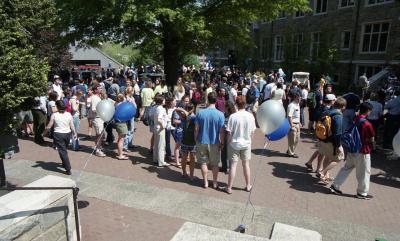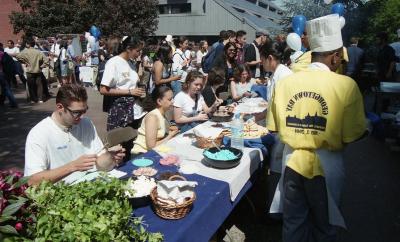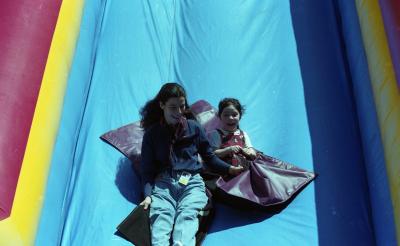Every year, Georgetown Day falls on the last Friday of Spring semester classes. Officially, the University hosts a formal campus-wide celebration with food, performances, and activities on Healy and Copley lawns. Unofficially, Georgetown Day is a notorious display of undergraduate drunken debauchery. As The Georgetown Voice reported in 2015, “Anything goes on Georgetown Day: sipping out of questionable water bottles during class (that is, if you decide to go to class), killing your Spanish oral exam because you are drunk, killing your final presentation because you are drunk, and falling asleep on Healy Lawn at 1:15 in the afternoon.”1
Origins
Georgetown Day emerged in response to the tragic death of junior David Shick (MSB '01) in February 2000 after an altercation in the Lauinger Library parking lot2. Returning from a sports bar, Shick and a group of friends encountered another group of students; one student from the latter group punched Shick after the two bumped into each other, causing Shick to fall and hit his head on a curb3. He died of his injuries four days later4.
Concerns that alcohol had fueled the altercation, supported by an MPD officer's statement that "It appears there had been some alcohol consumption by various parties"5, led the university to drop its support for the usual spring block party in the days following Shick's death6. The Tombs also changed its 99 Days tradition to allow students to drink any beverage, not just beer, to complete the tradition7.
That May, at the end of a semester that included Shick’s passing and a series of incidents involving antisemitic, racist, and homophobic graffiti, the campus community needed a space to come together and heal.8The University responded by organizing the first Georgetown Day, a day filled with carnival amusements, live entertainment by student performers, and games sponsored by various campus groups. The University also founded the Dorothy Brown Award, which is presented on Georgetown Day to “an outstanding faculty member whose contributions demonstrate a strong commitment to the educational advancement of students.”9
Evolving traditions
Georgetown Day in 2002 took on a more celebratory tone with a morning interfaith service followed by a dunk-tank, carnival rides, rock climbing walls, student art displays, a student performance of Cabaret, and an evening comedy show headlined by Tracy Morgan.10That day, the community consumed more than 7 pounds of cotton candy, 5,000 hamburgers, 10,000 hot dogs, and 2,000 veggie burgers, and a Georgetown Day filled with food and revelry officially became an annual tradition.11
Over the years, the University has struggled to protect Georgetown Day’s original purpose and prevent the debauchery described in The Georgetown Voice. In 2009, after the University inadvertently scheduled a GAAP weekend that coincided with the traditional Georgetown Day Friday, rumors flew about a possible postponement or cancellation. University Provost James O’Donnell assuaged student concern with an announcement that Georgetown Day would proceed as originally scheduled, as the University was committed to an event that "brings together students, faculty and staff to mark the end of another academic year, when the flowers are blooming and the sun is shining, but before finals and graduation.”12
Changing university plans
Three years later, a lack of student interest and involvement in planning Georgetown Day forced the University to scale back and rethink the schedule of prior years. 2012's Georgetown Day did not feature any inflatables, and the University decided against continuing the recent tradition of a beer garden in “an attempt to create a more welcoming atmosphere for students of all ages and discourage public alcohol consumption.”13University officials reaffirmed a commitment to a “celebration of the community in all its parts” rather than “a celebration by the community, or more accurately, by the student community.”14
In 2014, the inflatables returned along with a $50,000 cost for the day’s events. The University spent $11,000 on security, $8,000 on food, $7,000 on performers, $9,000 on sound equipment, $6,000 on inflatables, $4,000 on giveaways, $2,000 on venues, $2,000 on volunteer incentives (food, t-shirts, small gifts), $1,000 on other equipment, and $1,000 for non-volunteer labor.15
In 2015, concerned by the poor recycling and wasteful habits of prior years, The Corp initiated a Georgetown Day Cup. Prize money was awarded on a group and individual basis to those who brought the largest number of red Solo cups and aluminum cans to stations set up around campus. That year the University also began investing in late-night Georgetown Day programming at the Healey Family Student Center. From 10pm until 1am, students had access to free pizza and wings, an all-night happy hour in Bulldog Tavern, video games, and a showing of “The Wedding Ringer.”16
2019 Changes
In 2019, the University was again forced to address the culture of Georgetown Day. GERMS, Georgetown Emergency Response Medical Service, responded to an unprecedented fifteen calls on Georgetown Day 2018 compared to eight calls on Homecoming and six calls on St. Patrick’s Day. In an effort to rein in dangerous levels of alcohol consumption, the University imposed a series of new campus-wide protocols. All Georgetown Day 2019 parties had to be registered a week in advance with designated hosts wearing wristbands, and any breaches of the Student Code of Conduct over Georgetown Day weekend required an additional fifteen work sanction hours for expungement from offenders’ disciplinary records.17
Virtual Georgetown Day
In 2020, the COVID-19 pandemic forced Georgetown Day celebrations online. Faculty members read reviews from Rate My Professor, students put on the traditional musical performances, Jack the Bulldog made an appearance, and President DeGioia gave a prerecorded address. Over 300 students attended the virtual event.18
- 1Brennan, Grace. "Traditions at Georgetown." The Georgetown Voice. 31 July 2015.
- 2Gitelman, Yana. "David Shick and the forgotten legacy of Georgetown Day." The Georgetown Voice. 28 April 2023.
- 3Gitelman, Yana. "David Shick and the forgotten legacy of Georgetown Day." The Georgetown Voice. 28 April 2023.
- 4Gitelman, Yana. "David Shick and the forgotten legacy of Georgetown Day." The Georgetown Voice. 28 April 2023.
- 5"Junior Dies After Incident." The Hoya. 25 February 2000.
- 6Andrea, Andreas. "University Withdraws Support for Block Party." The Hoya. 29 February 2000.
- 7Andrea, Andreas. "University Withdraws Support for Block Party." The Hoya. 29 February 2000.
- 8Haggerty, Tim. “Community Celebrates Second Georgetown Day.” The Hoya. 4 May 2001.
- 9Dorothy Brown Award, Georgetown University, Office of the Provost.
- 10Doherty, Joe. “Georgetown Day Celebrates Community Spirit.” The Hoya. 30 April 2002.
- 11“Community Celebrates Second Georgetown Day.”
- 12McGinnis, Emily. “Georgetown Day to Proceed in Spite of Campus Rumors.” The Hoya. 12 Feb. 2009.
- 13Byrne, Mariah. “Georgetown Day to Be Scaled Back.” The Hoya. 19 March 2012.
- 14Id.
- 15Moore, Maddy. “The High Price Tag of Georgetown Day.” 11 April 2014.
- 16Garzillo, Tom. “Georgetown Day Celebrates 15 Years.” The Hoya. 24 April 2015.
- 17Ferrante, Casey. “Stricter Penalties Set for Georgetown Day.” The Hoya. 26 April 2019.
- 18Testa, Giulia. “Students, Faculty Celebrate Virtual Georgetown Day.” The Hoya. 30 April 2020.





